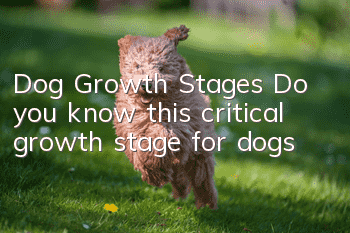Dog Growth Stages Do you know this critical growth stage for dogs?

Puppy growth period
1. Diet: Weaning at 30 days of age, reducing the number of feedings every day, increasing the amount of puppy food, and completely weaning off breast milk at 6 weeks of age.2. Bathing: It is not recommended to bathe a dog that is too young. It is easy to get sick due to its resistance. You can choose to wipe it with a wet towel and then blow it dry. Take a bath two weeks after the first shot of vaccine and when it is 2 months old.
3. Vaccine: The first shot (6-8 weeks) of two-shot vaccine; the second shot (12 weeks) of quadruple vaccine; the third shot (16 weeks) of six-shot + rabies vaccine. Four weeks after the third dose (approximately 20 weeks), a serum antibody test will be performed.
4. Deworming: The first internal deworming is recommended when the dog is 3-6 weeks old and before the first vaccination.
5. Training: Dogs can be trained between 3-6 months old. The dog needs to be familiar with commands and names.
Dog Maturity and Growth Period
A dog’s first estrus usually begins around 8 months of age. The timing varies for different breeds. On average, dogs go into estrus twice a year, 6 months apart. There are also differences in breeds. Female dogs can use menstrual pants to maintain hygiene during estrus. Male dogs should try to bring a leash when going out. In order to avoid estrus, they can also choose to be sterilized.Dog’s prime growth period
The prime time of a dog’s life, from three to six years old, is equivalent to an adult in his 20s or 30s. Dogs have gradually grown into stable adult dogs. During this period, dogs are more susceptible to injury because their energy is still strong. As they approach 5 to 6 years of age, large dogs like Great Danes may begin to act more like older dogs and develop health problems.Old growth period of dogs
In the old age, the body functions of dogs begin to deteriorate. Because of different breeds, the differences in aging are also very obvious. Large dogs age faster than smaller dogs. Their golden years are between 2 and 8 years old. After the age of 8, their ability to perform work begins to decrease. Large dogs will have more joint or bone problems, such as the eyes and ears of dogs. , heart, kidney, pancreas, etc. may have problems at any time. It is recommended that the owner take the dog for a physical examination every six months, regular deworming, and regular vaccination. Random articles
- Is it better for Dogo dogs to have their ears erect or cropped? A case of Dogo dog’s ear erection surgery will tell you
- What do dogs eat to protect their stomach? It is important to protect their stomach and treat gastrointestinal diseases in dogs.
- How to tell if your dog is fat? Is your dog overweight?
- How to train Tibetan Mastiff Four aspects teach you how to train Tibetan Mastiff
- Will your dog catch a cold if you blow the air conditioner? What should you do if your dog catches a cold if you blow the air conditioner?
- What should you pay attention to when your dog drinks water? Don’t be careless when it comes to your dog’s drinking water.
- The dog's mouth bites and shakes. Why does the dog's mouth occasionally shake and bite?
- How to cut a dog's hair? Do you know how to cut a dog's hair correctly?
- Can dogs eat raw eggs? Why can’t dogs eat egg whites?
- Common Dog Problems in Summer How to Deal with Different Dog Problems



